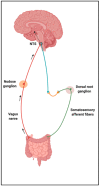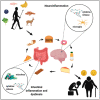Evolution of the Human Diet and Its Impact on Gut Microbiota, Immune Responses, and Brain Health
- PMID: 33435203
- PMCID: PMC7826636
- DOI: 10.3390/nu13010196
Evolution of the Human Diet and Its Impact on Gut Microbiota, Immune Responses, and Brain Health
Abstract
The relatively rapid shift from consuming preagricultural wild foods for thousands of years, to consuming postindustrial semi-processed and ultra-processed foods endemic of the Western world less than 200 years ago did not allow for evolutionary adaptation of the commensal microbial species that inhabit the human gastrointestinal (GI) tract, and this has significantly impacted gut health. The human gut microbiota, the diverse and dynamic population of microbes, has been demonstrated to have extensive and important interactions with the digestive, immune, and nervous systems. Western diet-induced dysbiosis of the gut microbiota has been shown to negatively impact human digestive physiology, to have pathogenic effects on the immune system, and, in turn, cause exaggerated neuroinflammation. Given the tremendous amount of evidence linking neuroinflammation with neural dysfunction, it is no surprise that the Western diet has been implicated in the development of many diseases and disorders of the brain, including memory impairments, neurodegenerative disorders, and depression. In this review, we discuss each of these concepts to understand how what we eat can lead to cognitive and psychiatric diseases.
Keywords: aging; depression; gut dysbiosis; human diet evolution; microbiota; neurodegeneration; neuroinflammation.
Conflict of interest statement
The authors declare no conflict of interest.
Figures




References
-
- Shackleton C.M., Granger J.E. Bone marrow fat index and kidney-fat index of several antelope species from Transkei. S. Afr. J. Wildl. Res. 1989;19:129–134.
Publication types
MeSH terms
Grants and funding
LinkOut - more resources
Full Text Sources
Other Literature Sources

